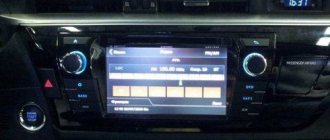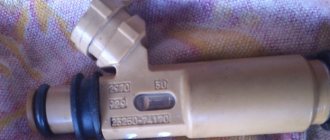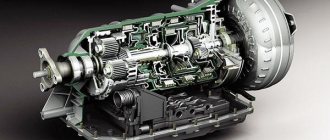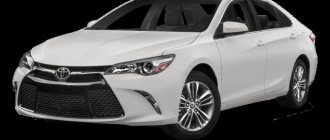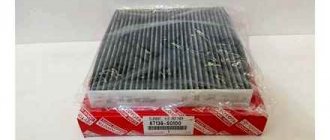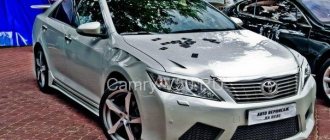High consumption of lubricant by the machine affects the wear of the motor. An indicator of how much oil a car consumes is the impact that mileage has. This problem can be explained by:
- Oil seals and gas distribution device parts have lost their elasticity.
- The piston rings are worn.
- There is an oil leak.
- The air filter was clogged.
- Using low quality motor lubricant.
If an increase in consumption has been noticed due to engine wear, then before starting troubleshooting the engine, it is recommended to check the following problems:
- Oil contamination in exhaust gases. A gas analyzer will help detect the problem; to do this, you need to measure the composition of the gas.
- Check the motor for external leaks.
- Carrying out compression measurements in cylinders. Its indicator should be from ten to thirteen point nine bar. If compression is low, add a small amount of lubricant and measure again. If after this the pressure rises, then the root of the problem is in the cylinder-piston group. If the compression remains unchanged, then the valves are the cause.
- Determine the specific amount of lubricant consumption.
Reasons for oil consumption
The first sign of increased engine wear is “burning” of engine oil. The mileage directly affects the “appetite” of the power unit. The causes of this problem may be:
- trivial leaks (from under the oil filter housing, valve covers, engine pan gasket);
- wear or loss of elasticity of valve stem seals (intake and exhaust valve seals), parts of the gas distribution mechanism (the appearance of unacceptable gaps between the inner surface of the cylinder head guides and the valves);
- sticking or wear of piston rings (oil scraper, compression);
- Among the rare exceptions are the fact of using counterfeit or low-quality motor oil, setting an early ignition timing as a result of malfunctions of the electronic engine control unit (for example, after CHIP tuning).
Another common reason when the engine is forced to consume oil is excessive clogging of the air filter. If the engine can’t breathe, then it pulls air from wherever it can (along with oil).
Only diagnostics at a service center will help you determine exactly why the Toyota Kamry 40 eats oil. An external inspection of the engine does not always help to identify the causes, especially if they are hidden from prying eyes and are located under the valve cover.
Controls and working with them Toyota Camry 2001-
The most popular sedan produced by the Toyota Corporation has repeatedly appeared in heated discussions among car enthusiasts and critics. But this did not stop the Camry from going through 7 generations and a number of restylings, remaining an invariably popular model in its segment. We will talk about the Toyota Camry dashboard - a multifunctional part that favorably emphasizes the executive class of the car.
The seventh generation of the sedan was released in 2011. The resounding success of the manufacturer's model inspired, and 3 years of active sales ended with the Camry restyling. The updates affected the technical content of the engines and body design. External and internal style took a special place, and the car acquired a modified instrument control panel. Why is he remarkable?
Characteristic signs of high oil consumption
In most cases, original valve seals are sold at a price of 61-351 rubles/piece. (according to Yandex.Market) and are available in two colors: brown (for exhaust) and black caps (for intake).
In their manufacture, different rubber is used (heat-resistant for exhaust valves). An annular spring is installed on the top of the cap, ensuring tight compression of the valve stem. The outer lower part is metal, the inner part is rubber. This technical solution ensures reliable sealed fastening of the oil seal on the valve guide pressed into the cylinder head.
Caps of a different color may be available for different engine models (depending on the manufacturer). Beware of fakes. Be sure to consult with the seller!
A truly high consumption of engine oil can be considered if the owner is forced to add more than one liter for every 1000 km.
| № | Method for determining increased engine oil consumption |
| 1 | A sign of a leak in the intake valve seals is the appearance of blue smoke after starting a cold engine (a black tint “indicates” a rich fuel mixture, white smoke is steam). |
| 2 | The appearance of smoke in the crankcase ventilation breather pipe indicates that the seals have become rough and the exhaust valves have become depressurized. |
| 3 | A thick layer of carbon deposits on the glow plugs will indicate problems with the valve stem seals. |
If the car “eats” oil from the engine crankcase, then it’s time to make repairs and restore the tightness of the gas distribution mechanism.
Fuel consumption per 100 km for Toyota Camry (2006 - 2009), Sedan, XV40 [restyling]
| Modification | Fuel consumption, l/100 km | Power reserve (km.) | ||
| highway | city | MIX | ||
| 2494 cm³, 179 hp, tank (70 l.) - AI-95, automatic transmission, front-wheel drive | 7.3 | 10.6 | — | 660 — 960 |
| 2494 cm³, 179 hp, tank (70 l.) - AI-95, manual transmission, front-wheel drive | 7.1 | 10.6 | — | 660 — 990 |
| 3456 cm³, 277 hp, tank (70 l.) - AI-95, automatic transmission, front-wheel drive | 7.4 | 14.1 | — | 500 — 950 |
| 2362 cm³, 169 hp, tank (70 l.) - AI-95, automatic transmission, front-wheel drive | 7.8 | 13.6 | — | 510 — 900 |
| 2362 cm³, 169 hp, tank (70 l.) - AI-95, manual transmission, front-wheel drive | 6.7 | 11.6 | — | 600 — 1040 |
| 2362 cm³, 147 hp, tank (65 l.) - AI-95, CVT, front-wheel drive | 6.9 | 7.1 | — | 920 — 940 |
When operating cars, owners are faced with increased fuel consumption, which differs from the values declared by the factory by 10-20%. The reason for the discrepancy is driving conditions that differ from the test site (traffic jams, moving short distances, excessive pressure on the gas pedal when accelerating). As the mileage increases, transmission and chassis components wear out, which leads to increased mechanical losses and decreased efficiency.
Replacing valve stem seals on Camry 40
During a major overhaul of an internal combustion engine (for example, with a volume of 2.4 liters) this is a mandatory procedure and it is highly contraindicated to neglect it. Saving costs at this time, in the future, will definitely force the owner to return and comply with technical regulations.
In cases where a car with low mileage has already begun to gradually “eat” engine oil, when to change the valve seals, the owner of the vehicle decides for himself.
If the lubrication level does not drop below a critical level, routine repairs can be postponed for some time. When, during the operation of the car, the owner is forced to add oil to the engine, at least once, not to mention multiple replenishment of the lubrication crankcase, then it is necessary to carry out a restoration repair of the cylinder head.
So that the work is carried out by motorists of the service center. They provide guarantees for the work performed.
People who have theoretical knowledge, practical experience in replacing valve stem seals, tools and special devices can make repairs with their own hands.
Keep in mind! You can change the oil seals on site without removing the cylinder head.
Exclamation mark (!). Engine capacity 20
A modern on-board computer is a device that collects, stores and analyzes information about the operation of the most important components of a car to monitor the state of fuel consumption, coolant, oil, temperature conditions with the ability to diagnose mechanical components and prevent their malfunctions. Since the engine volume ranged from 1.8 to 2.0 liters and an 8-valve gas distribution system was used, the average gasoline consumption (octane number from 92 units) was 8-9 liters per 100 km; in urban conditions the parameter increased to 10-12 liters .
Helpful tips for replacing valve seals
You will need a tool for unscrewing the mounting bolts and nuts, a “breaker” and a device for placing an object between the piston and the valve plate inside the cylinder (put through the hole for the glow plug). What to do:
- remove all attachments from the engine that will provide free access to the valve cover;
- unscrew the spark plugs and remove the valve cover;
- remove the camshafts and hydraulic valve clearance compensators;
- crank the engine (using the front crankshaft pulley) so that the piston of the first cylinder goes up. When 1.5-2 cm remains before TDC, carefully insert the device between the valve plate and the piston bottom. Turn the crankshaft in the upward direction, without exerting force while pressing the lining;
- fix the cracker, compress the spring and remove the crackers from the upper valve cup;
- remove and set them aside. Use a special tool to remove the old oil seal;
- Lubricate the new oil seal with engine oil and, using a nozzle, install it onto the valve guide pressed into the cylinder head;
- install the spring, compress it using a cracker, insert crackers;
- turn the crankshaft in the opposite direction and move the substrate over the other valve, pressing it with the piston.
Repeat the procedure with all valves and reassemble the engine in the reverse order of disassembly.
Comments
The pinout of one of the Toyota Camry SV40 instrument panel connection connectors is shown in the figure. The connection diagram to the electrical equipment of the car is shown in the figure. The connection diagram to the electrical equipment of the car. If the car has a different pinout of connectors, reconnection of the connections is required in accordance with the electrical diagram of this Camry car model. Price of Camry dashboards 40 Article number of the factory dashboard Camry V40 Serial number F On the secondary market, such a model can be found at a price ranging from up to rubles. The fourth generation of the Toyota Camry V40 was introduced in 1994; this version of the car was offered only in a sedan body, but, as before, it had a Vista platform model.
Conclusions © Precautions
| On-board computer Toyota Camry 40: setup - do-it-yourself car repair You can also see the rear broom, which is not available in all trim levels. The bottom photo shows the interior brake light, which the car seemed to be equipped with if a spoiler was not installed. On the secondary market, this model is one of the most popular cars, and, for good reason, it is a comfortable, roomy premium sedan at the price of a budget Korean in a top-end configuration. |
- driving mode;
- air temperature;
- quality of road surface;
- use of heating and air conditioning;
- use of tires appropriate for the season;
- loading the car.
Toyota Camry 6th generation XV40 • Transmission was offered manual or automatic with 5 steps.
Toyota Camry 7th generation 3.5 l
The volume of the fuel tank of Toyota Camry cars of 40 different configurations officially supplied to the CIS market is 70 liters. In cars with automatic transmission and 2.4-liter engines, this amount of fuel is enough to cover 700 kilometers in mixed mode, when the average consumption is 9.9 liters. Mechanics will allow you to drive more. In a car with a manual transmission, the driver will cover 850 kilometers before the next refueling. In a car with a 3.5-liter power unit and an automatic transmission, you can cover 700 kilometers on one gas tank, all other things being equal.
Toyota Camry 5th generation gasoline consumption per 100 km. Reviews
- Oleg, Khabarovsk. Toyota Camry 2005, 2.4AT engine. The car was purchased for daily use, as a company car. It's a great workhorse, but the fact that the car is 10 years old and I'm the fifth owner means it's stupid to expect it to be in perfect working condition. Although I didn’t spend that much on repairs - everything was within reason. Consumption is certainly high - on average in the city it is 11 liters per 100 km.
- Maxim, Barnaul. Toyota Camry in body 30, 2005. The most common engine is a 2.4 liter automatic. At first I was not too happy with the car - it was a bit heavy and clumsy to drive, but over time I realized that this was actually an advantage, since all the bumps in the road were absorbed completely unnoticeably. Consumption depends very much on how you drive - usually I have 10-11 liters in the city, but sometimes it can be 13 liters.
- Mikhail, Moscow. I bought my 2003 Camry in 2011. My wife really insisted on the Auris, but I liked the Camry for its solidity. It drives very smoothly, like a ship, fuel consumption is completely independent of the air conditioning, like on my old Honda - stable 11-11.5 liters per 100 km.
- Artem, Biysk. Despite the fact that I switched to Camry from a “ten”, I have a couple of serious comments about the Japanese. Firstly, there is no illumination of many options - at night you simply can’t get where you need to go. Secondly, the BC does not show the fuel level - it did on the VAZ-2110, but it doesn’t show here. Well, a tape recorder for cassettes is simply nonsense even for a 2003 model. In terms of consumption, I have a manual and it rules. On the highway, consumption is from 7 to 8 liters, in the city – 9-11 liters.
- Maxim, Volchikha. I drive a 2002 Toyota Camry, with a 3.0AT engine. The car is just super - at first it seems like it’s not moving at all, but you look at the speedometer - it’s 150 km/h, but you don’t feel it at all. At this speed, the consumption is about 10 liters; in the city, if you don’t heat it, then the consumption is the same.
- Konstantin, Krasnoyarsk. I bought my Toyota Camry in 2012. There wasn’t much money, so the choice was either a new domestic car or a used foreign car, I chose the latter option. On principle, I didn’t want to get involved in loans. The car was purchased from my boss - ideally and at a discount. I’m very pleased with the purchase - I won’t write about convenience and comfort, I’ll write about consumption. I fill up with AI-98, the consumption in mixed mode city + highway at 50% comes out to 6.9 liters, if purely in the city - then 10 liters. Engine 2.4AT.
- Sergey, Shashinsk. Camry, V30 body, 2.4 automatic engine. Year of manufacture - 2003. All my life I have exclusively preferred Toyotas - I think that they are truly one of the best and highest quality cars. After Premio I bought myself a Camry. But Kamryukha let me down - at 120 thousand the cylinder head gasket blew and the engine had to be overhauled. In terms of consumption - up to capital in the city it was about 12.5 liters, on the highway from 8 to 10 depending on the speed.
- Askhat, Almaty. After buying a Toyota Camry, I had the feeling that I was driving not a car, but a Titanic - it didn’t drive, but literally floated. The car is in the XLE configuration, it has everything you need, starting from a powerful 3-liter engine and ending with an excellent audio system. Consumption is appropriate - from 8-9 on the highway to 13 in the city.
- Sergey, Novosibirsk. In 2012, I was offered a Toyota Camry at a very interesting price. I took a friend of mine to a service station, and they examined the car as if they were carrying drugs in it. The equipment is luxurious, leather, full power accessories and all that. Year of manufacture 2002, but excellent condition. The engine is 2.4 liters with an automatic transmission, but I drive aggressively, so in the city my consumption in the winter reaches 18 liters, in the summer it is consistently 14 liters. For my wife, this figure is at least 3 liters less.
- Alexander, Krasnoyarsk. Camry V30, 2.4AT, 2004. I bought the car from the second owner in 2012. The downside is that the rear suspension was rickety and had to be completely rebuilt. But it's not a problem. The engine didn’t burn oil - I used Toyota branded 5w-40. Consumption from 7.5 liters on the highway to 11-12 in the city - I plan to reflash the engine to reduce consumption a little.
- Leonid, Novosibirsk. I took a car manufactured in 2002, but regretted it - I should have taken it younger, after 2004. It’s not a matter of 2 years, but the fact that the 2AZ engine was brought to life only after restyling in 2004, and so it has a disease - it pulls bolts from the cylinder head. But there are no complaints about the power of the engine, it’s just great. The only thing is that with an automatic, of course, the consumption is rather considerable - in the summer 13 liters, in the winter up to 18 liters with frequent warm-ups. On the highway it’s less – about 8 liters.
Fuel consumption per 100 km for Toyota Camry, Sedan, V10 – Model xv40
| Toyota Camry 40 eats oil Control lamp for VSC stability control system This lamp warns of a malfunction in the vehicle's stability control system or traction control system (Fig. If the oil level does not fall below the recommended mark on the dipstick during prolonged use, then the planned replacement can be postponed for a short period of time. |
- Evgeniy, Tyumen. Before Toyota there was a Focus - I was irritated by the cramped interior and the dull operation of the variator. The Camry does not have these shortcomings - the interior is spacious and comfortable, and you can hardly feel the automatic transmission working, the gears shift so smoothly. On the highway the consumption is 10 liters - I drive at least 120-140 km/h, in the city it comes out to 13-13.5 liters.
- Alexander, Novy Urengoy. Camry 2011, 3.5AT engine. My first car - there’s nothing to compare it with. As for me, everything is just cool, there’s a herd of 277 horses under the hood, a huge interior – it’s just a rocket. I don’t get too hot on the highway yet, maximum 110-120 km/h, so the consumption is around 8 liters. City - 13-15 liters, in winter it was generally 25 liters - but we have severe frosts.
- Maxim, Novosibirsk. Toyota Camry, XV40 body, 3.5AT, 2007. The fortieth body is the most successful among the entire Camry line - the new “fifty” is absolutely faceless against its background. The motor is so powerful that you even feel an excess of traction. Consumption is naturally serious - in the city on average it comes out to about 15 liters, on the highway 10-11 liters. But this is normal - after all, 3500 cubes, after all.
- Ivan, Nadym. The car is very good, but not the gearbox – the automatic in the model with a 3.5 liter engine is very problematic. I don’t recommend taking it, because I’m not the only one who has encountered this problem - I read on the Internet that many people have a similar problem. Consumption 9 highway, 13 city.
- Alexey, Ekaterinburg. The six-speed automatic that is installed on the Camry with a 3.5-liter engine is very successful - at least the engine consumption is almost the same as the 2.4 and all because of the gearbox. My colleague at work has the same one, but with a 2.4 engine, so on the highway he spends almost as much as I do - up to 9 liters. In the city, of course, I have more - in the summer it’s stable 15 liters, in the winter up to 20 liters.
- Evgeniy, Chita. After purchasing my Toyota Camry 3.5AT, I expected that gasoline would be consumed in buckets and was prepared for huge consumption - after all, it had 280 horsepower. But the consumption really surprised me - on the highway it was 9 liters per 100 km at a speed of 140 km/h! The city is naturally larger - in summer 13 l, in winter from 17 to 25 (depending on frost).
- Batyr, Ulan-Ude. The car is wonderful, but don’t forget that this is still an E-class, not a business class. Therefore, there are some disadvantages, for example, insufficient lateral support, it is difficult to take sharp turns, and so on. On the other hand, the price of the car is completely adequate and the gas consumption is reasonable - on the highway on average 8.2 liters, in the city in the summer 12.5 liters, in the cold 15-16 liters.
- Maxim, Surgut. Toyota Camry, XV40 body, 3.5AT, 2006, mileage 120 thousand km. Everything is fine, no complaints. After the purchase, a full diagnostic was carried out, consumables were replaced, and minor things were done - there were no major repairs. Average consumption is 18 liters (I count it for winter, since I bought it in winter). For our city, it’s still not the best option - front-wheel drive, and the engine is too powerful for a single-wheel drive and slips.
- Nikolay, Omsk. This is a good car for everyone, except for the quality of the paintwork. I am the second owner, I went to the bodybuilders - there are so many chips on the body that I am simply shocked. It feels like we are driving somewhere in a rocky desert. In all other respects, I am completely satisfied with the car - comfortable, convenient and the dynamics are amazing. Consumption in the city is 14-16 liters, highway 8-9 liters.
- Vasily, Nefteskvazhinsk. I switched to Toyota Camry from Priora. I can’t even describe the feelings that I experienced over the next couple of months. I have a 2008 car, with a 3.5 liter engine and an automatic transmission. The engine is not strangled - 277 horses, I even think that this is a lot, because at the slightest press on the pedal the car simply flies away. On the highway with cruise and quiet driving, consumption is 6.8 liters. The Priora had 6 liters. In the city in the winter it’s 17-19, it takes a long time to heat it up - it’s better to warm it up for an extra 10 minutes than to repair the box later.
